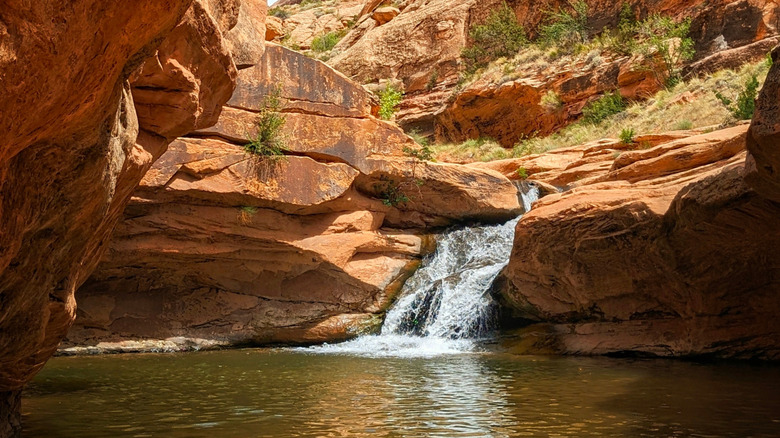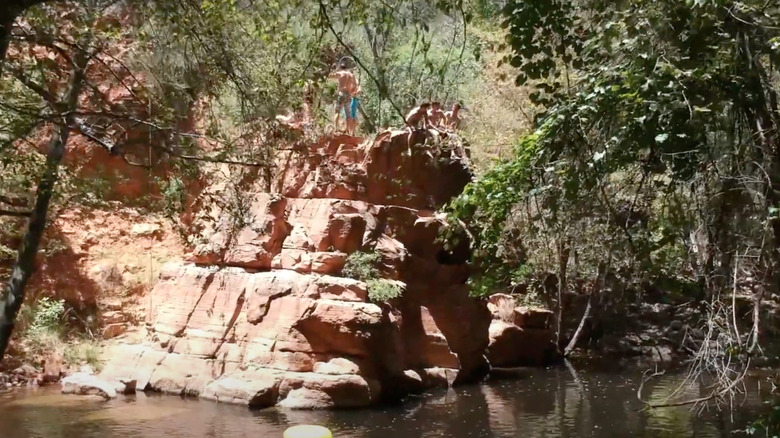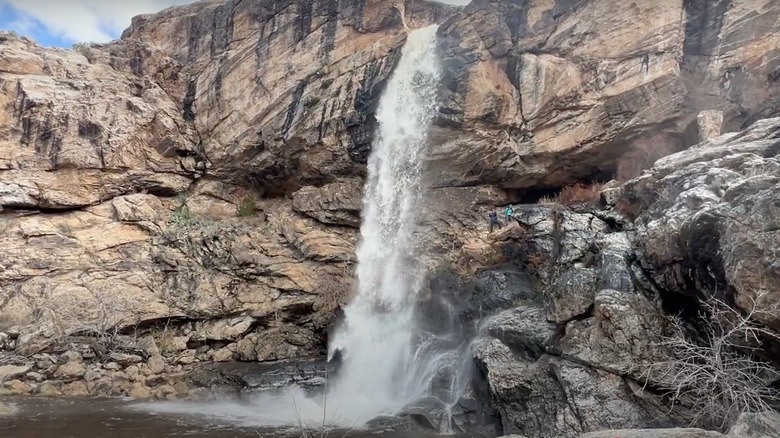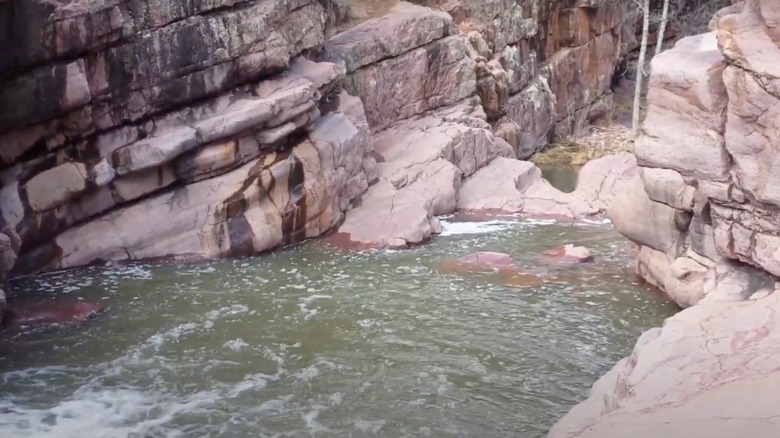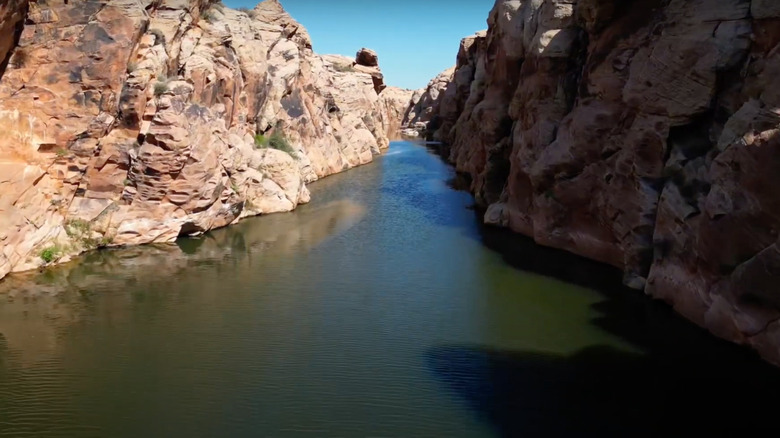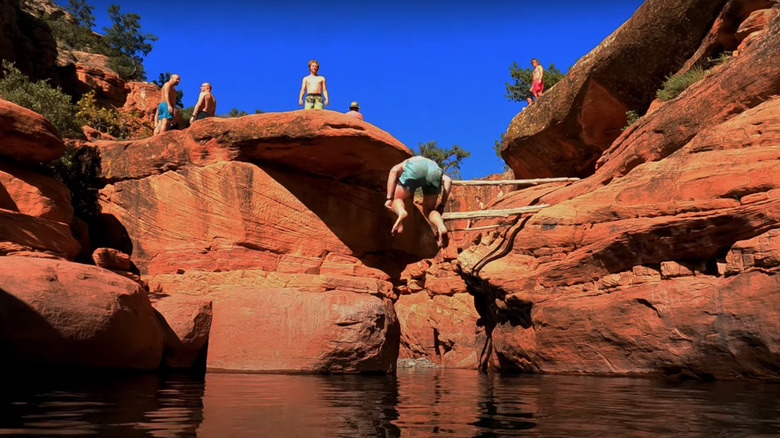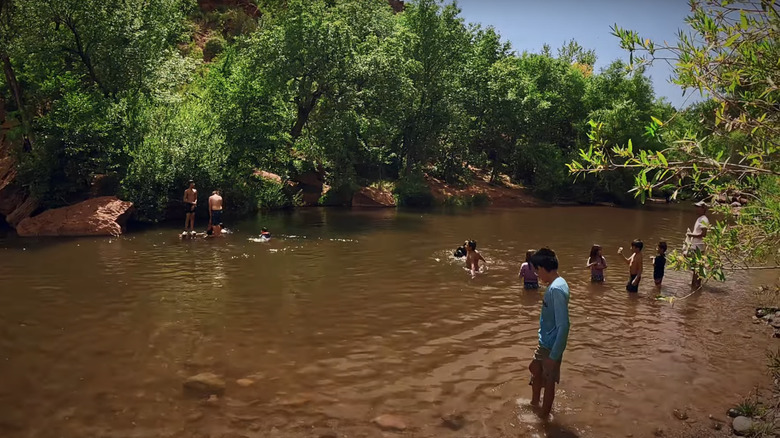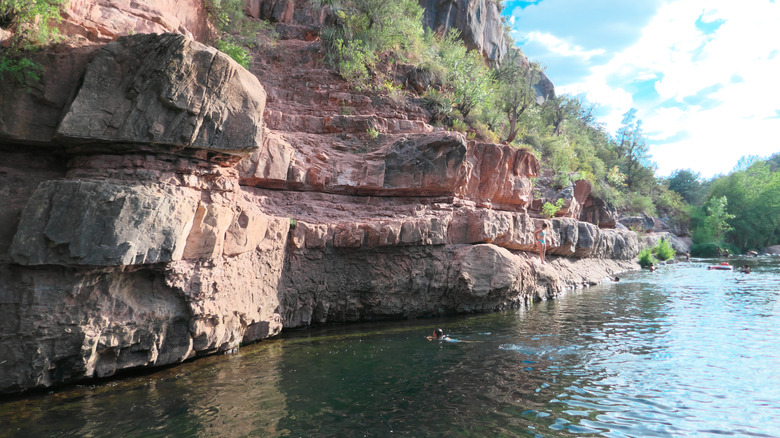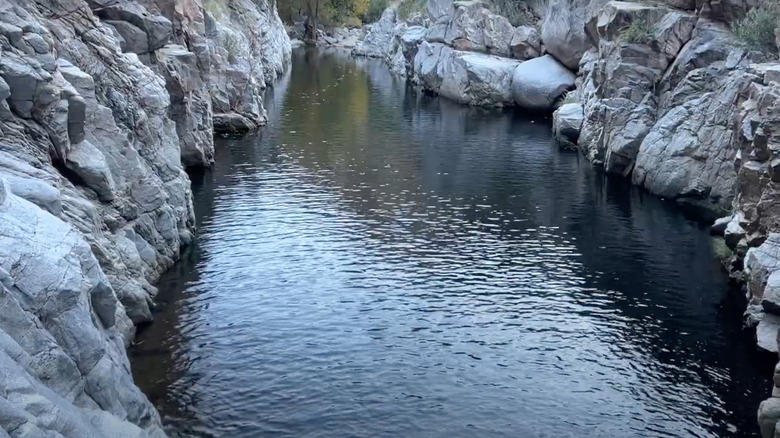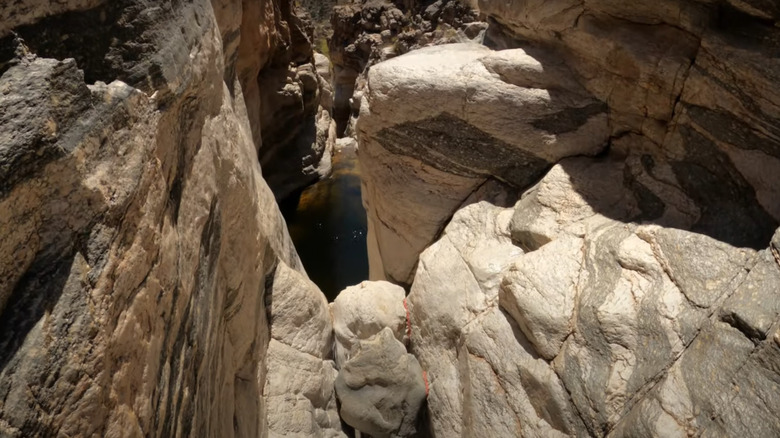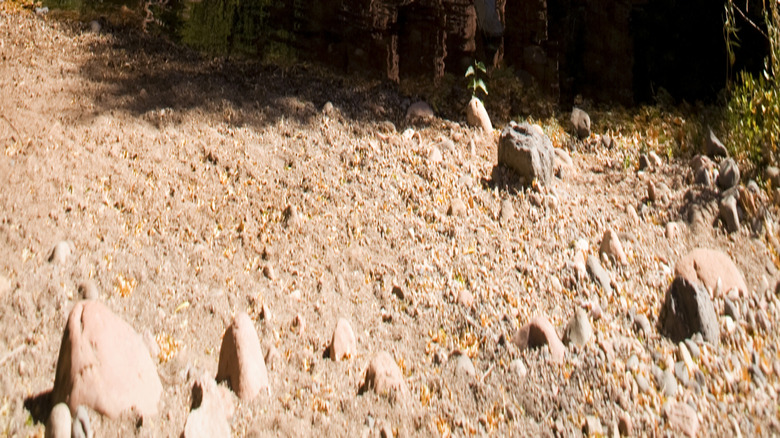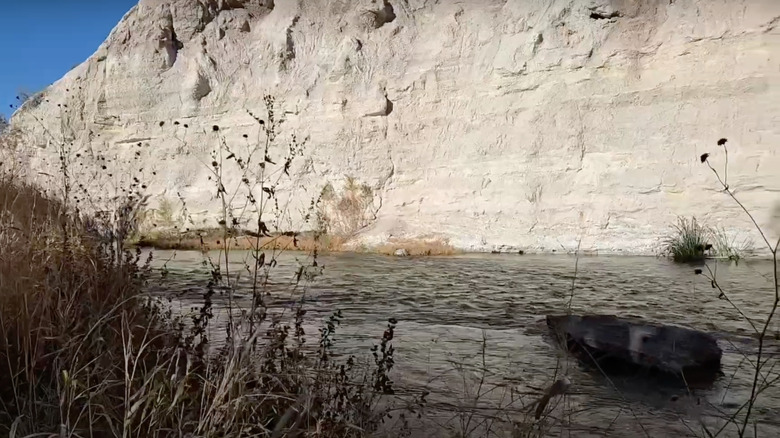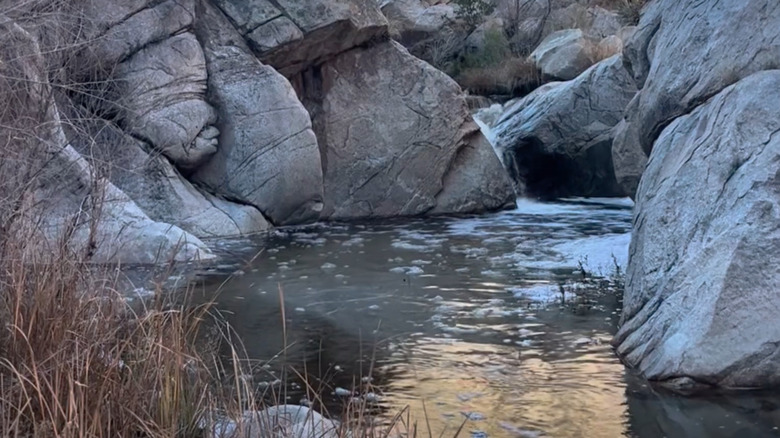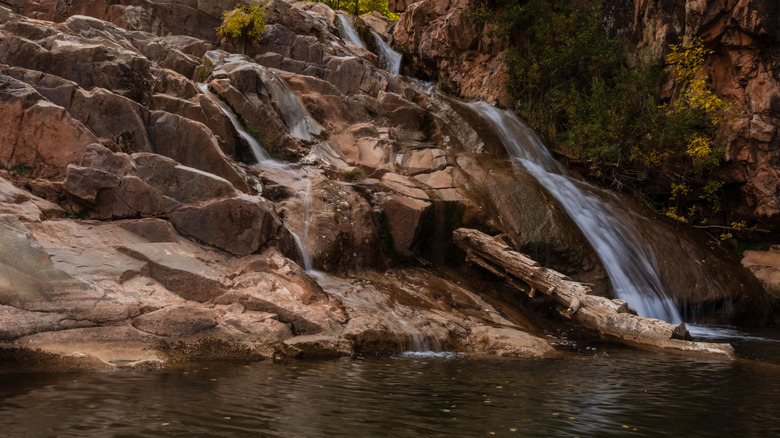Secret Swimming Holes In Arizona That Are Worth Discovering
A landlocked state that is known for its dry climate, Arizona might not immediately come to mind when you think of places to go for a swim. This, after all, is the only state in the U.S. home to four deserts (Chihuahuan, Great Basin, Mohave, and Sonoran). Vast swathes of the state are technically termed as arid, getting less than 10 inches of rain per year. But Arizona does have some fine geological formations — it is the home of the Grand Canyon, just plan your trip during this ultimate time of the year.
There are canyons all over the state, formed by the constant cutting and erosion of waterways that wind through them, as well as lakes, rivers, and reservoirs. And while there might not be endless gorgeous waterfalls where you can swim, there are a wealth of swimming holes. On a searing hot summer day, or even a mildly pleasant winter's afternoon, finding one of these bodies of water for a refreshing dip is pure bliss. While some of them are very well-known, and well-visited, like Havasu Falls in Grand Canyon National Park, others manage to operate under the radar. Some of those secret ones are easy to reach, others require some serious hiking, but what they all have in common is that they are worth the trip. Slide into one as the sun's rays beat down on you, and you'll understand why.
Bull Pen Swimming Hole
East of the town of Camp Verde, this swimming hole sits within the wilderness of the Bull Pen Day Use Area. Getting to the cooling body of water is relatively straightforward, though visitors will need to drive down a dirt road for a few miles before getting to the trailhead for the West Clear Creek Trail. The hike itself to the swimming hole is less than a mile, but expect only light shade along part of the way, while sections of the trail are fully exposed to the sun. The hole is ideal for visitors of all ages, with some sections easy to slip into right from the side.
Certain parts are very shallow, so travelers with young kids can spend time there without any concerns. Further away from the rocky shoreline, the water gets markedly deeper, and it is also deep in the section just below a vertiginous clump of red rock that looks like an iceberg cast in clay. This is perfect for the more adventurous visitor, since some of the ledges on the rock are more than 15 feet above the water, making them ideal launching points for cliff jumpers. Take the leap, and you'll soon find yourself in cool water that's pure relief from the searing Arizona sun.
Chiva Falls
In the wilds east of Tucson, a city of culinary excellence, these falls thunder down more than 70 feet. They generally only appear when there is rain in the area, or following a substantial melt of snow. Visitors will not only enjoy the soothing sounds of the roaring cascade but also the swimming hole it creates at the bottom. The destination sits near the Rincon Mountains, with the falls themselves set within the Joaquin Canyon. The trail can be traversed in a number of ways, with some travelers making the journey in a 4x4 vehicle, or an ATV to navigate the hilly, rocky terrain.
The hardy might venture there on a mountain bike, but for others, hiking is the most viable option. The trek itself is challenging, with large portions of it out in the open, with no shade from the sun. We recommend setting out early in the morning. The walk rumbles along open scrubland, past cacti, and with views of mountains in the distance. The base of the falls is the best place to cool off. For some more excitement, visitors can clamber up sections of granite to access a cave that is behind the falls.
Christopher Creek Canyon
Refreshing water is the hallmark of this canyon popular with cliff jumpers and canyoneering enthusiasts. Also known as Box Canyon, the area is an assemblage of craggy rock faces and ledges, the angles and textures shaped by the eroding forces of Christopher Creek. Look at the rocks, and you'll see hints of red and pink in the layers. The creek traverses a variety of mediums as it winds its way down the canyon, from naturally smoothed slides to roiling rapids to tranquil pools.
Adventurers can be spotted in the gorge hopping and leaping from waterway to waterway, clambering over rock faces, and leaping into pools before wading out onto the next challenge. The water, shaded from the sun's rays for much of the day, remains cool to the touch, offering a pleasing respite to visitors looking to chill out. Christopher Creek Canyon is located southeast of Camp Verde, and its campground can be reached in a couple of hours when driving from Phoenix.
Clear Creek Reservoir
In the center of the state, near Winslow, East Clear Creek splinters off from the Little Colorado River. Part of the creek is bookended by a dam, so rather than being a torrent of rushing water, the creek feels more like a lake and is known as Clear Creek Reservoir. On either side of the narrow reservoir, sandstone cliffs make a sheer, sudden ascent, making this a great spot for cliff jumpers. It is also a fantastic spot for kayaking, with the sharply rising walls of sandstone making the water feel protected, serene, and mysterious.
Trips typically start at McHood Park in Winslow, an unremarkable place that serves as an access point into the reservoir. The most peaceful part of the reservoir is a quick trip upstream, when the canyon walls surge upwards, and the scene is one of serenity and solitude. Near the park, swimmers and cliff-jumpers are often in abundance, but head less than a mile upstream, and you will feel like you are in your own magical realm. There are ample places to scramble up the canyon walls and leap in, while some of the rocks have petroglyphs on them.
The Crack
A waterway that is in Red Rock Country, Wet Beaver Creek winds through the Colorado Plateau and draws travelers looking to escape urban life. The Crack is a specific section of the creek where a slender body of water inhabits a channel between high cliffs of rock. Getting there requires that visitors embark on a hike, a few miles in length, that doesn't have much shade. Even if spring and fall are great times for the walk, summer is when the water in The Crack will feel the most refreshing.
Note though, that the heat can be debilitating, so visitors in summer should carry plenty of water, and set off early for the most comfortable hiking conditions. The Bell Trail leads to the destination and is generally flat most of the way, with the occasional climbs. Once at The Crack, visitors might notice the slab of rock that looks like a diving board. There are numerous ledges where travelers can steady themselves before leaping into the swimming hole. Logs of wood that bridge the two sides of the canyon also allow adventurers another option for a jumping spot, or simply a way to cross from one side to the other. To get there from Sedona, anticipate a drive of about 30 minutes or so.
Crescent Moon Picnic Site
This site is another easy destination to reach from Sedona, situated a short distance to the southwest of the city, in the heart of Red Rock Country. What makes it extra special, apart from the tranquil waters that just beg to be experienced, are the views. While paddling in the shallows of Oak Creek, visitors can look up and see the iconic Cathedral Rock. With buttes of red rock rising either side of a soaring fingers of rock, Cathedral Rock is special, and a visual treat that adds to the allure of this swimming hole.
Crescent Moon draws travelers looking for some serenity, as well as the chance to fish, relax, take photos to fill their Instagram feed, and even have a picnic. Tourists that come during the week will find that the spot is quiet, perhaps even empty; what's not to love about that? It is the kind of place that draws plaudits from commenters on Tripadvisor, like this one. "I was so taken back by the swimming areas like this one that Sedona has. We spent four hours here swimming and hanging out, some shallow areas as well as a deeper spot to jump in at."
Grasshopper Point Swimming & Picnic Area
The pool sits at the bottom of the vertiginous Oak Creek Canyon, a famed scenic overlook, and supplies a fine place to cool off on summer days. The setting of the pool itself is picturesque, with the clear water showcasing large, smooth pebbles on the bed of the swimming hole. Trees skirt one side of the water, while a mountain of red rocks rises almost like a series of terraces on the other, so there are plenty of places to lounge, soak up the sun, or leap into the water. Thanks to the arrangement of the rocks and trees, visitors will be able to find shade if they want to escape the sunlight.
Since access is a short walk from a paid parking lot, this is a smart spot to visit on sweltering days since no long hike is required to get there. A commenter on Tripadvisor concurs. "We did this on a hot summer's day in July after hiking Devil's Bridge. What a treat it was. The clean and cool water was so refreshing and there was ample room to swim. There are spots you can jump into the water as well if you like." Hikers can also visit to hit a few trails that radiate from the parking lot. This attractive swimming hole can be found a few miles northeast of Sedona.
Hutch's Pool
Northeast of Tucson, in the foothills of the Santa Catalina Mountains, this pool has water all year, which is remarkable considering where it is located. Alas, the summer months can be dangerously hot to hike there, so visitors should time their visit for other periods of the year. Getting to the pool requires some commitment, as visitors must hike a few miles to reach the pool. The walk rumbles along the Sabino Canyon valley, with sharp inclines rising on either side of the route.
Cactus and low desert bushes add a bit of color to the scenery, while clear blue skies overhead mean there is little shade for travelers. Gnarled, dried trees add an eerie element to the hike. The pool itself has a sandy area around its edge and comes with views of a canyon, so even if you don't swim, it's a pretty place to relax. As a contributor from Google notes, "What a gem of a spot where the Sabino Creek picks up water volume from a nearby tributary and some rocks creating a narrowed canyon and pool."
Milagrosa Canyon
Another destination northeast of Tucson, these narrow pools are hemmed in by towering white cliffs and canyons. Finding this magical spot requires a hike through rocky inclines. Expect a workout for the quads, as you will have to tackle some giant boulders of Catalina Gneiss, a hardened rock that has become smoothed over time by the elements. Some of the giant rocks look like they've been haphazardly dropped with no rhyme or reason, making navigation of them a tricky proposition, though maybe not quite on the level of some national park trails only for experienced hikers.
But persist, and eventually the pools of Milagrosa Canyon will reveal themselves. There are a handful of pools there, one with a shallow entry and deep waters that are bone-chillingly cold, even in the summer. Getting the other pools requires some creative climbing, and while these pools are shallower than the first, they are equally refreshing. Thanks to the walls of smoothed, curved granite that virtually cut off the sunlight, the water remains bracing to the touch, and the Milagrosa Canyon Pools feel like a secret hideaway.
Parsons Spring
The Parsons Trail is what travelers will need to take to encounter this large pool. The hike drops at the beginning before it traces the winding line of a desert stream as it meanders along a section of red rock. Some parts feel a little removed from the arid environs of Arizona, especially if songbirds call from the branches of cottonwood trees. The route sometimes passes by small pools and crosses creeks. The trail also showcases the varied colors of the canyon walls, with bands of sandstone, limestone, and dark, moody basalt.
After four miles, the trail arrives at Parson Springs, formed when an underground channel of water breaks the surface. Trees sit on one side of the swimming hole, while a sheer wall of red rock rises on the other side. For visitors in the fall, the scenery brings with it the added benefit of the leaves changing color. To reach the trailhead, come via the nearest town, Clarkdale, which sits a few miles to the south.
Rockin' River Ranch State Park
Extending slightly over 200 acres, this park sits where the Verde River and the West Clear Creek meet. It's a scenic spot for spending the day, with opportunities to fish, or hike under cottonwood and sycamore trees. Some trails not only take in the grand expanses of nature, but they also open to inspiring views of undulating mountain ridges in the distance. On a walk, visitors might spot deer, otters, and javelinas (it looks like a cross between a rodent and pa ig), as well as several birds.
Ornithologists might fawn over the chance to spot summer tanager, wood ducks, great blue herons, and even some bald eagles. For travelers looking to escape the Arizona heat, the park also supplies a stretch of the Verde River that is perfect for a calming, restorative plunge. This is a pretty spot, a calm body of water gently flowing under striated white cliffs. The new park (it opened in February 2024), sits a short hop southeast of Camp Verde.
Romero Pools
Expect a solid hike to get to these pools in Catalina State Park near Tucson. As the name of the park suggests, it sits at the foot of the Santa Catalina Mountains and is a fine example of Arizona desert wilderness. Visitors will find more than 5,000 acres of terrain, ranging from canyons and streams to foothills and plains. There are thousands of saguaros there, as well as opportunities to go biking and horse riding (the park features a dedicated equestrian center). Visit at the right time of year, and you will also be able to see wildflowers blooming, a sight that anyone who has seen California's iconic wildflowers will certainly appreciate.
The hike to the pools passes over streams that vary in force depending on the rainfall or snowmelt. Before reaching the Romero Pools, adventurers can take a quick detour to the Montrose Pools, which are small, but ideal for a stop and perhaps a dip of the feet. In summation, the trek starts with a section of flat, before morphing into one that requires a climb up toward the Romero Pools. The swimming holes vary in form, even though they are next to each other. Some are set within a bowl of rock, partially shaded for much of the day, while lower ones are more open to the sun. Waterfalls feed each one, though the cascades of the upper pools are more impressive. Expect cold water during a visit; if you make the hike during the summer, you might even spot rattlesnakes.
Water Wheel Falls
Almost due north of Payson, this fun-filled destination combines a pretty waterfall with a swimming hole. It doesn't require undue exertion to get to Water Wheel Falls, with the total hike less than a two-mile roundtrip, with not much elevation. Visitors will follow the Water Wheel Falls Hiking Trail, which commonly appears on maps online. The trail begins as a partially shaded walk, cutting through trees near this part of the state where Ellison Creek and the Verde River commune. The flat area eventually transforms into smoothed rock and a canyon and then a climb up to areas with water.
If there has been recent rainfall, it is important to tread with caution, as the rocks can get slick, and very slippery. During the hike, expect to wind through creeks and see a number of waterfalls on the way to the swimming hole. The name of the pool comes from an old, worn water wheel that sits a short distance off the trail. When you reach the swimming hole, expect a calm body of water fed by cascades that stream down smoothed rock faces, and a sheer wall of rock that provides shades to some parts of the water. All that's left to do is to strip off, jump in, and revel in the simple luxury of the experience.
